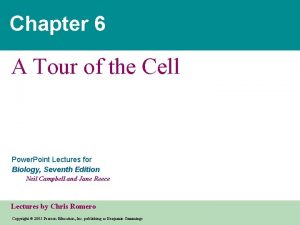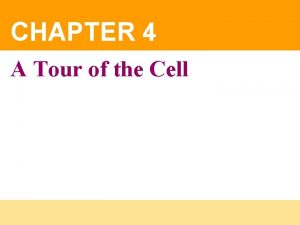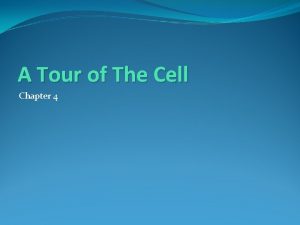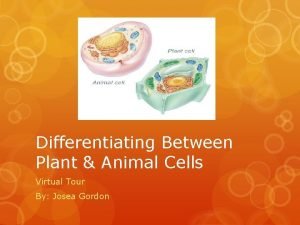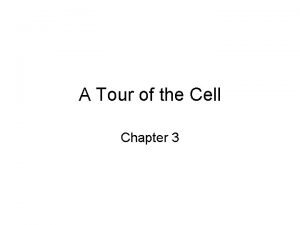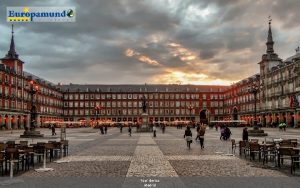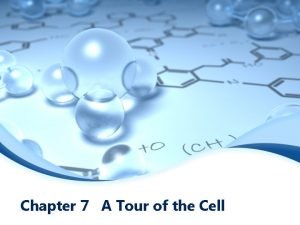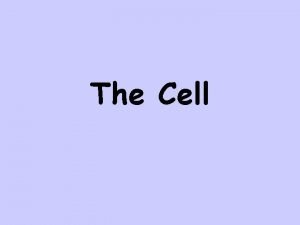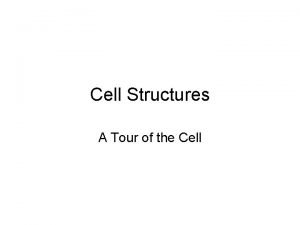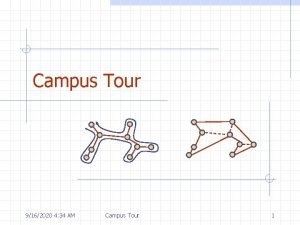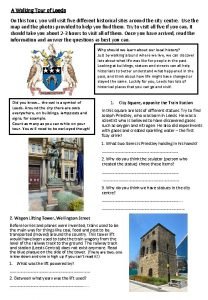CHAPTER 6 A Tour of the Cell CELL





































- Slides: 37

CHAPTER 6 A Tour of the Cell

CELL THEORY All organisms are made of one or more cells. Cells are the basic unit of structure and function in living things Cells arise by division of pre- existing cells.

How do we study cells? Cytology • Microscopes • Light microscopes • Electron microscopes • Transmission (TEM) • Scanning electron microscope (SEM)

Light Microscopy (LM) vs. Electron Microscopy (EM)

COMPARISONS OF SCOPES Light Electron Visible light passes through specimen Refracts light so specimen is magnified Magnify up to 1000 X Specimen can be alive/moving Color Can’t see organelles other than nucleus Focuses a beam of electrons through/onto specimen Magnify up to 1, 000 times Specimen non-living and in vacuum Can see organelles

ELECTRON MICROSCOPY Transmission (TEM) 2 -D, study internal structures of cells Creates a flat image with extreme detail Can enhance contrast by staining atoms with heavy metal dyes Images called a micrograph Scanning (SEM) 3 -D Used for detailed study of surface of specimen Gives great field of depth Sample covered with thin film of gold, beam excited electrons on surface

Studying cell structure & function 1. Cell fractionation - take apart cells, separate major organelles 2. Ultracentrifuge applies force 1 million times the force of gravity to separate further the cell organelles with the most dense at the bottom

CELL SIZE AND SCALE https: //www. youtube. com/watch? v=wu. XSEOKNx. N 8&featur e=related- why small 6 min anderson

As cell size increases, the SA/V ration decreases, rates of chemical exchange may then be inadequate for cell size Cells must remain small to maintain a large surface area to volume ratio Large S. A. allows increased rates of chemical exchange between cell and environment

2 TYPES OF CELLS: 1. Prokaryotes: Domain Bacteria & Archaea 2. Eukaryotes (Domain Eukarya): Protists, Fungi, Plants, Animals

PROKARYOTE VS. Has nucleus and nuclear No nucleus (Nucleoid-DNA EUKARYOTE envelope concentration) DNA in a nucleoid Cytoplasm/Cytosol No organelles other than ribosomes Small size Primitive i. e. bacteria Cytoplasm/Cytosol Membrane-bound organelles with specialized structure/function Much larger in size More complex i. e. plant/animal cell

A PROKARYOTIC CELL (BACTERIA)

EUKARYOTIC CELLS

NUCLEUS Function: control center of cell Contains genetic material Surrounded by double membrane with pores(nuclear envelope) Continuous with the rough ER Nuclear side of envelope lined with a network of protein filaments (Nuclear Lamina)- maintain shape Nuclear pores: control what enters/leaves nucleus Chromatin: complex of DNA + proteins; makes up chromosomes Nucleolus: region where ribosomal subunits are formed

NUCLEUS Contains DNA Function: control center of cell Surrounded by double membrane (nuclear envelope) Continuous with the rough ER Nuclear pores: control what enters/leaves nucleus Chromatin: complex of DNA + proteins; makes up chromosomes Nucleolus: region where ribosomal subunits are formed

RIBOSOMES Function: protein synthesis Composed of r. RNA + protein Large subunit + small subunit Types: 1. Free ribosomes: float in cytosol, produce proteins used within cell 2. Bound ribosomes: attached to ER, make proteins for export from cell

ENDOMEMBRANE SYSTEM: -Regulates protein traffic & performs metabolic functions - Includes: nuclear envelope, ER, Golgi, Lysosomes, Vacuoles, and Plasma Membrane

ENDOPLASMIC RETICULUM (ER) Network of membranes and sacs that are continuous with nuclear envelope Types: 1. Rough ER: ribosomes on surface Function: package proteins for secretion, send transport vesicles to Golgi, make replacement membrane 2. Smooth ER: no ribosomes on surface Function: synthesize lipids, metabolize carbs, detox drugs & poisons (in liver), store Ca 2+ (muscles)- helps regulate muscle contraction

ENDOPLASMIC RETICULUM (ER)

GOLGI APPARATUS Function: modify, store, & ship proteins Flattened sacs of membranes arranged in stacks Cisternae: flattened membranous sacs that receives vesicles Cis Face : receiving Trans face: shipping

endoplasmic reticulum nucleus protein on its way! DNA RNA vesicle TO: vesicle ribosomes TO: finished protein Making Proteins Golgi apparatus

LYSOSOMES Function little “stomach” of the cell digests macromolecules “clean up crew” of the cell cleans up broken down organelles Structure vesicles of digestive enzymes only in animal cells synthesized by r. ER, transferred to Golgi

WHEN THINGS GO BAD… Diseases of lysosomes are often fatal digestive enzyme not working in lysosome picks up biomolecules, but can’t digest one lysosomes fill up with undigested material grow larger & larger until disrupts cell & organ function lysosomal storage diseases more than 40 known diseases example: Tay-Sachs disease build up undigested fat in brain cells

BUT SOMETIMES CELLS NEED TO DIE… Lysosomes can be used to kill cells when they are supposed to be destroyed programmed development control of cell growth some cells have to die for proper development in an organism apoptosis “auto-destruct” process lysosomes break open & kill cell ex: tadpole tail gets re-absorbed when it turns into a frog ex: loss of webbing between your fingers during fetal development

SAC Functions: break down fatty acids to sugars; detox cell of alcohol and other poisons Found in plants and animals Involves production of hydrogen peroxide (H 2 O 2) , which is broken down by catalase (imports H) resulting in water and oxygen Glyoxysomes: convert oils to sugars in seeds for energy source

VACUOLES Function: storage of food, water, minerals Membrane-bound vesicles Eg. food vacuoles, contractile vacuoles Plants: large central vacuole -- stores water, ions

VACUOLES & VESICLES Vesicles: transporting Vacuoles: storing Food vacuoles Contractile vacuoles phagocytosis, fuse with lysosomes in freshwater protists, pump excess H 2 O out of cell Central vacuoles in many mature plant cells, Stockpile proteins, hold pigments, Store defense compounds

REVIEW http: //www. youtube. com/watch? v=aczb. Ml. SMr 8 U 10 min anderson

ENERGY ORGANELLES https: //www. youtube. com/watch? v=Zr. Nt 1 Fa. Uxe 0 8 min Cells must convert incoming energy to forms that they can use for work mitochondria: ATP from glucose to ATP = active energy chloroplasts: from sunlight to ATP & carbohydrates = stored energy ATP +

CHLOROPLASTS- PLANTS ONLY Function: site of photosynthesis (converts light energy into chemical energy ie. carbohydrates) Contains chlorophyll (green pigment) for capturing sunlight energy Why internal sac membranes? increase surface area for membrane-bound enzymes that synthesize ATP

CHLOROPLASTS Chloroplasts are plant organelles class of plant structures = plastids amyloplasts store starch in roots & tubers chromoplasts store pigments for fruits & flowers chloroplasts store chlorophyll & function in photosynthesis in leaves, other green structures of plants & in eukaryotic algae

MEMBRANE-BOUND ENZYMES carbon + water + energy glucose + oxygen dioxide 6 CO 2 + 6 H 2 O + light energy C 6 H 12 O 6+ 6 O 2

MITOCHONDRIA- POWERHOUSE - Function: site of cellular respiration (use oxygen to make ATP, breaks down carbohydrates) Generate ATP in presence of Oxygen Break down larger molecule into smaller to generate energy= catabolism - Generate energy in presence of Oxygen (aerobic respiration) Why 2 membranes? increase surface area for membrane-bound enzymes that synthesize ATP

MITOCHONDRIA Almost all eukaryotic cells have mitochondria there may be 1 very large mitochondrion or 100 s to 1000 s of individual mitochondria number of mitochondria is correlated with aerobic metabolic activity more activity = more energy needed = more mitochondria What cells would have a lot of mitochondria? active cells: • muscle cells • nerve cells

MEMBRANE-BOUND ENZYMES glucose + oxygen carbon + water + energy dioxide C 6 H 12 O 6 + 6 O 2 6 CO 2 + 6 H 2 O + ATP

THE GREAT ENERGY CIRCLE OF LIFE sun Photosynthesis ATP plants CO 2 glucose sugar + H 2 O Respiration animals & plants ATP + O 2

ENDOSYMBIONT THEORY Mitochondria & chloroplasts share similar origin Prokaryotic cells engulfed by ancestors of eukaryotic cells Evidence: Double-membrane structure Transform energy Have own ribosomes & circular DNA, enzymes Reproduce independently within cell Semi-autonomous (move, divide, change shape)
 Shanghai world financial tour eiffel tour petronas
Shanghai world financial tour eiffel tour petronas Tour guide vs tour escort
Tour guide vs tour escort Bad world tour
Bad world tour Chapter 6 a tour of the cell answers
Chapter 6 a tour of the cell answers Chapter 4 a tour of the cell
Chapter 4 a tour of the cell A tour of the cell chapter 4
A tour of the cell chapter 4 Virtual plant cell
Virtual plant cell A tour inside the cell answers
A tour inside the cell answers Chapter 4 cell theory and cell study
Chapter 4 cell theory and cell study Hát kết hợp bộ gõ cơ thể
Hát kết hợp bộ gõ cơ thể Slidetodoc
Slidetodoc Bổ thể
Bổ thể Tỉ lệ cơ thể trẻ em
Tỉ lệ cơ thể trẻ em Chó sói
Chó sói Glasgow thang điểm
Glasgow thang điểm Hát lên người ơi alleluia
Hát lên người ơi alleluia Các môn thể thao bắt đầu bằng tiếng bóng
Các môn thể thao bắt đầu bằng tiếng bóng Thế nào là hệ số cao nhất
Thế nào là hệ số cao nhất Các châu lục và đại dương trên thế giới
Các châu lục và đại dương trên thế giới Công của trọng lực
Công của trọng lực Trời xanh đây là của chúng ta thể thơ
Trời xanh đây là của chúng ta thể thơ Cách giải mật thư tọa độ
Cách giải mật thư tọa độ 101012 bằng
101012 bằng độ dài liên kết
độ dài liên kết Các châu lục và đại dương trên thế giới
Các châu lục và đại dương trên thế giới Thể thơ truyền thống
Thể thơ truyền thống Quá trình desamine hóa có thể tạo ra
Quá trình desamine hóa có thể tạo ra Một số thể thơ truyền thống
Một số thể thơ truyền thống Cái miệng xinh xinh thế chỉ nói điều hay thôi
Cái miệng xinh xinh thế chỉ nói điều hay thôi Vẽ hình chiếu vuông góc của vật thể sau
Vẽ hình chiếu vuông góc của vật thể sau Biện pháp chống mỏi cơ
Biện pháp chống mỏi cơ đặc điểm cơ thể của người tối cổ
đặc điểm cơ thể của người tối cổ V. c c
V. c c Vẽ hình chiếu đứng bằng cạnh của vật thể
Vẽ hình chiếu đứng bằng cạnh của vật thể Vẽ hình chiếu vuông góc của vật thể sau
Vẽ hình chiếu vuông góc của vật thể sau Thẻ vin
Thẻ vin đại từ thay thế
đại từ thay thế điện thế nghỉ
điện thế nghỉ



